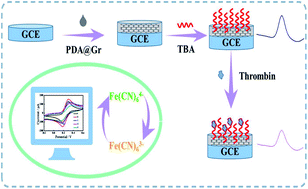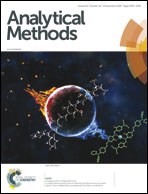A facile electrochemical aptasensing platform based on a polydopamine@graphene composite for protein detection
Abstract
In this article, we demonstrated a facile electrochemical aptasensing platform based on a polydopamine@graphene (PDA@Gr) composite using thrombin as a model. In the sensing process, PDA@Gr was obtained by depositing PDA on the surface of graphene nanosheets via self-polymerization under alkaline conditions. The composite was used as a matrix for immobilizing the aptamer due to the powerful adhesion properties of PDA to immobilize biomolecules. It also played a critical role in signal amplification. Upon binding of thrombin to the surface of the electrode due to the affinity between thrombin and its aptamer, the electron transfer rate was greatly reduced, resulting in the electrochemical signal decrease of [Fe(CN)6]3−/4−. The peak current changes increased with the increase of thrombin concentration. Based on this, a facile strategy for selective and sensitive detection of thrombin was developed. Under the optimal conditions, a dynamic response range from 1.0 × 10−16 to 1.0 × 10−13 mol L−1 with a detection limit of 1.0 × 10−16 mol L−1 (S/N = 3) was obtained. Also, the method can detect thrombin in diluted human blood serum with satisfactory results. More importantly, the strategy of this assay can be easily extended to immobilize other aptamers for detecting a wide range of targets in accordance with the demand.



 Please wait while we load your content...
Please wait while we load your content...